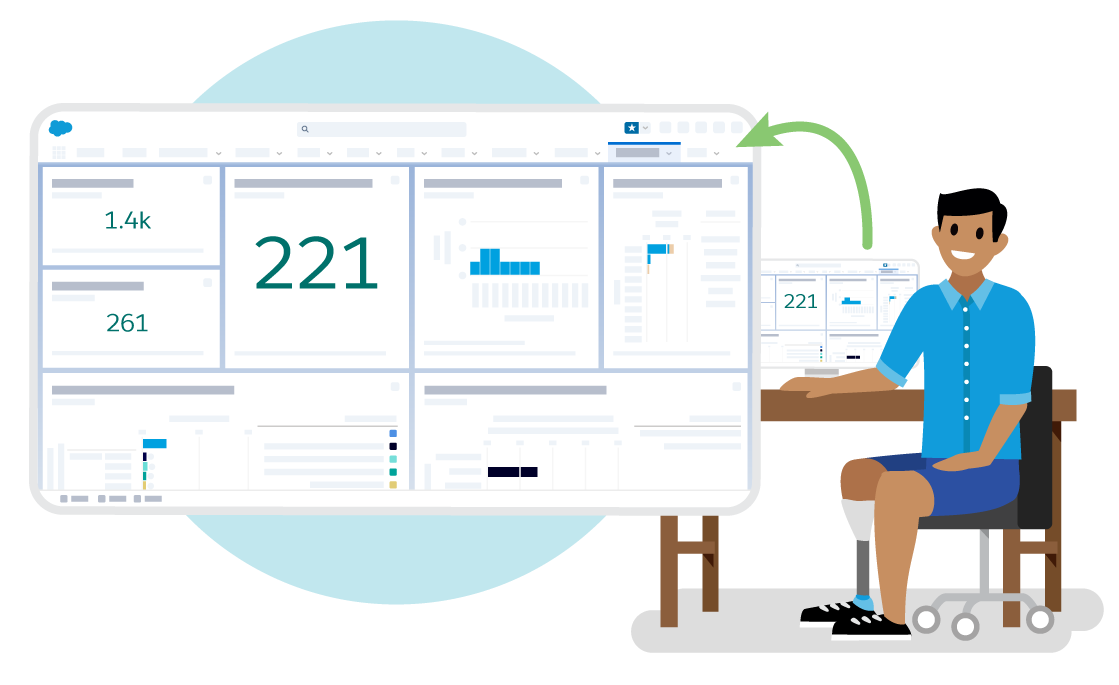Transform Your Business with Sales Engagement
Learning Objectives
After completing this unit, you’ll be able to:
- Describe how stakeholders use Sales Engagement.
- Explain how Sales Engagement delivers digital transformation to sales teams.
Meet the Stakeholders Who Use Sales Engagement
Sales Engagement is highly adaptable to your sales environment’s specific needs. Let’s take a look at Sales Engagement from different users’ perspectives, and find the advantages and efficiencies for your sales role.
Inside and Outside Sales Reps
Many companies have inside sales reps who handle all their tasks from a phone and computer setup. But in today’s digital world, the distinction between inside and outside sales is blurred. In 2021, Gartner stated that “...over a third of CSOs reported they are permanently transitioning some or all field sellers to virtual roles, and another third are considering it.”
“Virtual” sales techniques are very real; it’s just that they happen through technology. Today’s salespeople use email, messaging, video conferencing chat, and voice over IP (VoIP) as part of their sales process. These tools are essential for today’s sellers, particularly with distributed teams in remote, home-office, or hybrid settings. A 2023 Salesforce survey of over 3,300 business buyers worldwide shows that on average, business buyers engage with companies across 10 channels. Sales reps use Sales Engagement to add efficiency to the process across channels and close more deals.
Business Development and Lead Nurturing
Sales teams focused on developing new business track inbound and outbound engagements. Outbound efforts often take longer to nurture and grow into a full-fledged sale. Each inbound lead is a valuable potential seed for a sale, and delays in follow-up can result in lost revenue. Sales Engagement helps sales teams manage both inbound and outbound processes.
Sales Managers, Team Leaders, and Sales Operations
Managers direct overall team performance and coach their reps to help them accomplish individual goals. Managers and team leaders focus on data, deal metrics, sales forecasts, strategy, and continuous improvement. Sales Engagement provides dashboards and list views so managers and team leaders can track performance.
Sales operations personnel analyze the sales organization, optimize processes and systems, evaluate sales technology, and help guide sales strategy. Engagement tracking and automation in Sales Engagement help sales operations analyze and optimize the sales process.
Strategic decision makers work with Sales Engagement dashboards, engagement tracking data, and reports. They analyze the marketplace, assess the competition, and use customer insights to refine their sales tactics. Sales Engagement tools offer the insights and analysis to operate at scale and constantly improve a company’s sales process.
Managers onboard new hires faster with built-in processes and a simple, unified Sales Engagement interface. Managers retain top talent, too, because Sales Engagement equips sellers to focus more on selling and less on repetitive administrative tasks.
Repeat Sales, Add-On Sales, and Upselling
Current customers present easy additional revenue opportunities when Sales Engagement is used for automated outreach. Cadences can be set up to suggest companion products for add-on sales or to implement date-based outreach, such as for contract renewals.
All sales roles benefit from applying Sales Engagement tools for:
- Insights on faster, more efficient end-to-end processes.
- Integrated systems to alleviate busywork and increase work satisfaction.
- New levels of automation of best practices for scalable, measurable, and repeatable success.
Digital Transformation with Sales Engagement
Let’s check in with the team at our fictional sneaker manufacturer, Cloud Kicks. They’ve been using Sales Engagement for a while now, and they’ve seen some dramatic improvements.
Sales manager Jose sees the sales team as a model of streamlined efficiency since they implemented Sales Engagement. Instead of each sales rep trying 50 different processes, they’ve been able to standardize efforts with cadences and set up a continuous improvement loop to achieve sales goals. Jose views performance metrics on his dashboard and knows when things are moving in the right direction and where they need to make changes.

Jose is pleased with the quality of his team’s messaging now, and how easy it was for his team to master the new tools. Sales reps were receptive to using Sales Engagement when they saw it working within the platform they already knew.
Using cadences, Cloud Kicks sales rep Candace can handle more leads and advance deals through the pipeline faster. She has more time to focus on selling since her team has automated repetitive tasks that used to eat up hours every day. The To Do List helps her stay organized and manage all her tasks without worrying that she’s missed a key touchpoint with her leads and contacts.
All the Cloud Kicks salespeople are using automation, insights, and performance reporting to take their sales to the next level. The new tools feel seamless and frictionless, so Cloud Kicks buyers get personalized, consistent communication from sales reps. Jose sees his team has come a long way from the days when they were scrambling to handle new leads and existing customers.